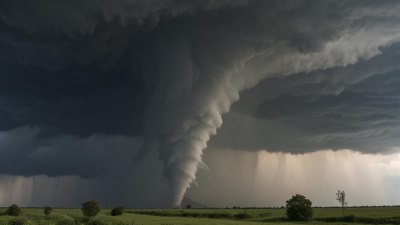What Is a Bomb Cyclone and Why It’s as Scary as It Sounds
Explore the phenomenon of bomb cyclones and their impacts on weather patterns, safety, and climate.

Image by ptckickcat on Freepik
A bomb cyclone is a rapidly intensifying low-pressure system characterized by a significant drop in atmospheric pressure in a short period, typically 24 hours. When the pressure decreases by at least 24 millibars in this timeframe, meteorologists classify the storm as a bomb cyclone. This phenomenon can lead to incredibly strong winds, heavy snowfall, and intense rainfall, making it one of the most severe weather events possible.
The term 'bomb cyclone' essentially describes a storm that 'bombs out' or explodes in intensity, leading to devastating weather conditions. These cyclones can produce blizzards, heavy rain, and flooding, causing widespread disruption and danger. Understanding bomb cyclones involves delving into meteorological science, their formation, impacts, and what they mean for our changing climate.
Formation and Characteristics of Bomb Cyclones
Bomb cyclones form when a low-pressure weather system interacts with high-pressure areas, which leads to a rapid decrease in atmospheric pressure. This pressure drop causes the winds to strengthen, pulling in moisture, and leading to significant precipitation. The crucial aspect of a bomb cyclone is not just the rain or snow it brings but the speed at which the system develops.
Typically, these storms start as a smaller low-pressure system that is influenced by warmer air from the tropics and colder air from the poles. The dynamic nature of air masses and the energy exchanges between them can create conditions ripe for explosive cyclogenesis, the technical term for this rapid intensification. As a result, bomb cyclones can exhibit extremely powerful winds that can exceed 70 mph in severe cases.
Impacts of Bomb Cyclones
Bomb cyclones are notorious for their potential to disrupt life. The strong winds can uproot trees, damage power lines, and wreak havoc on communities. Alongside wind damage, these storms can also bring heavy snowfall and blizzard conditions, which can lead to dangerous travel situations, road blockages, and significant snowfall accumulations in a short period.
Additionally, bomb cyclones can produce coastal flooding as winds blow water inland, especially during high tide. Coastal areas, particularly in the Northeastern U.S., experience severe impacts from these storms due to the combination of wind, rain, and storm surges. This leads to extensive flooding, property damage, and can threaten lives.
Examples of Notable Bomb Cyclones
Several notable bomb cyclones have influenced weather patterns in the U.S. and other parts of the world. One of the most infamous was the 'Blizzard of 1978,' which hit the northeastern states and resulted in severe snowstorms, crippling travel, and causing various fatalities. More recently, in January 2016, a powerful bomb cyclone affected the East Coast, packing winds of over 70 mph and producing blizzard conditions across several states.
Another significant event occurred in March 2019 when a bomb cyclone hit the central U.S., spurring heavy rain and snow and leading to major flooding across parts of Nebraska and surrounding areas. These events underscore the dangerous potential of bomb cyclones as they wreak havoc on infrastructure and natural landscapes alike.
Safety Precautions During a Bomb Cyclone
Given their potential for destruction, it is crucial for individuals and communities to prepare for bomb cyclones ahead of time. The first step is staying informed through local weather alerts and monitoring forecasts. When a storm is approaching, individuals should have an emergency kit ready, including water, non-perishable food, medications, and necessary supplies.
Moreover, securing loose objects around homes can prevent damage due to high winds. It’s also advisable to have a communication plan in place, ensuring family members know how to reach one another and where to go in the event of an emergency. Travel should be avoided unless absolutely necessary, as road conditions can deteriorate rapidly.
The Role of Climate Change
Interestingly, studies have shown that climate change may influence the frequency and intensity of bomb cyclones. As global temperatures rise, warm and cold air masses may interact in new ways, potentially resulting in more explosive cyclogenesis events. Additionally, warmer ocean temperatures can lead to more moisture in the atmosphere, providing additional fuel for storm systems.
As our climate continues to change, communities, meteorologists, and emergency planners must remain vigilant in understanding how these storms may evolve and affect regions that have not traditionally been prone to such occurrences.
In summary, bomb cyclones are severe weather systems that can lead to destructive impacts through strong winds, heavy snowfall, and flooding. Understanding their formation, potential dangers, and, importantly, how to prepare for them is essential for reducing risks associated with these formidable storms. With changing climatic patterns, staying aware of potential bomb cyclone activity is more important than ever to ensure safety and resilience in the face of these natural disasters.











